Food and Beverage Industry
VerifiedAdded on 2022/10/03
|16
|3879
|461
AI Summary
The essay discusses the modern food and beverage industry, industry ratings, trends, customer motivations and behavior, marketing strategies, operational and marketing tools, and Docklands Academy London’s partner restaurants.
Contribute Materials
Your contribution can guide someone’s learning journey. Share your
documents today.
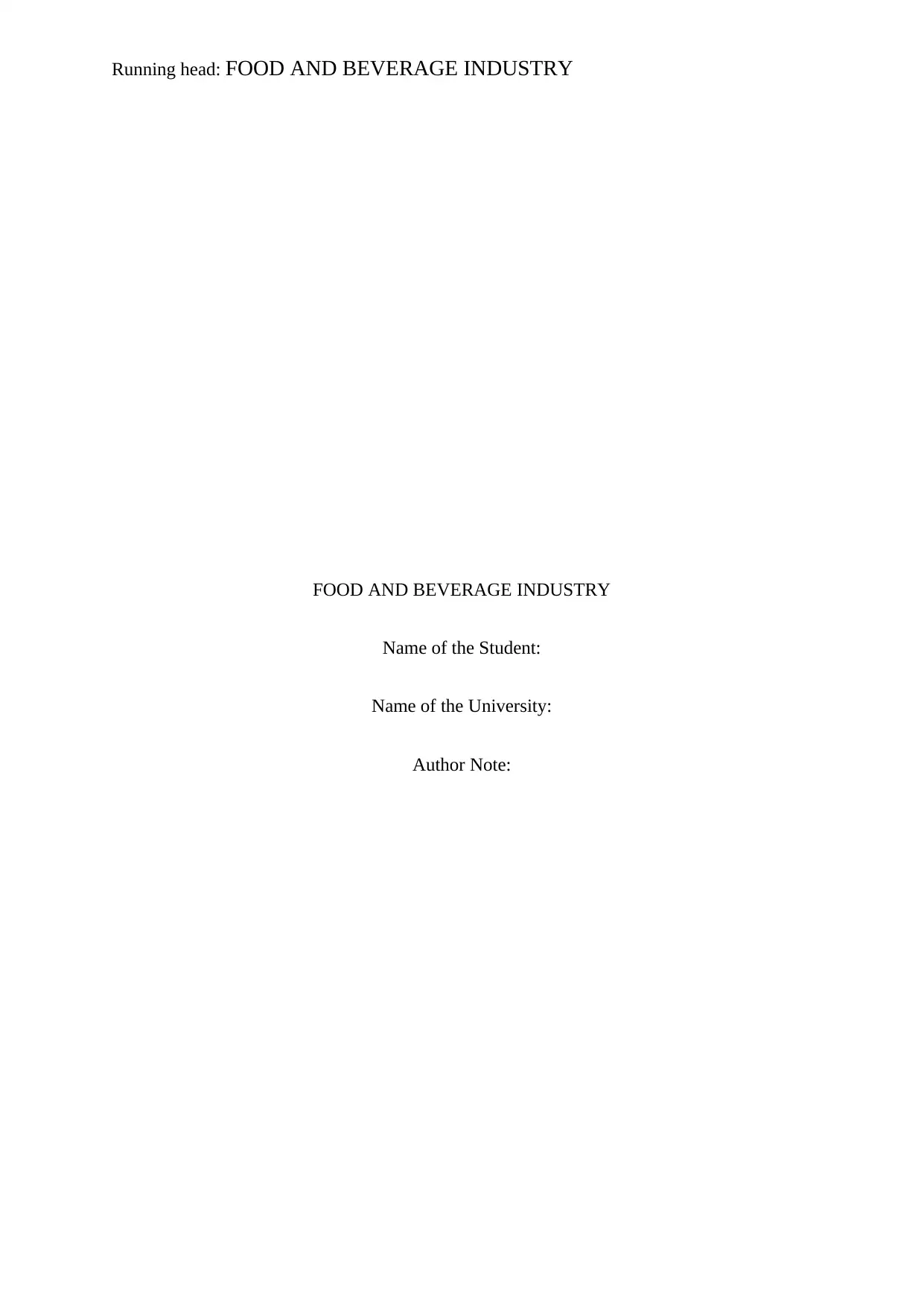
Running head: FOOD AND BEVERAGE INDUSTRY
FOOD AND BEVERAGE INDUSTRY
Name of the Student:
Name of the University:
Author Note:
FOOD AND BEVERAGE INDUSTRY
Name of the Student:
Name of the University:
Author Note:
Secure Best Marks with AI Grader
Need help grading? Try our AI Grader for instant feedback on your assignments.

1FOOD AND BEVERAGE INDUSTRY
Activity 1
The Modern Food and Beverage Industry
The food and beverage industry is referred to the industry that deals with the
manufacturing of the food, the processing of the food, and the distribution of the same. As
per the market analysts the food and beverage industry is one of the most complex industries,
as it involves the manufacturing of the food as well as the processing of the food, therefore,
the industry also includes the equipment and the chemical products involved in the business
as well. More importantly, the industry includes a very complex supply chain management
system, involving the farmers, the distributors, the sellers, the makers, the big business
organizations and the beverage houses included in the industry (Bohari, Hin and Fuad. 2017).
The industry also includes the professionals and the management system on the one hand and
on the other, it includes the wholesalers, the food services, the establishments and the
retailers and the fibre processors. The research and development process is also involved
within this industry which marks the development and exploration of the industry.
Therefore, in the following essay, a detailed evaluation of the food and beverage
enterprise of the Heathrow Airport Restaurant, will be blanketed, with a purpose to
essentially talk about the numerous styles of offerings and tends to be had inside the
enterprise, it'll also talk about the rating rules used by distinct organizations, and the customer
behaviour and the manifesting elements for the equal will as properly be discussed. Lastly,
the function of operations and technology might be included inside the dialogue.
Ca’puccino ( Offering authentic Italian coffee and regional Italian dishes)
Caffe Nero ( Providing finest Italian coffee)
Carluccio’s ( Restaurant, mainly offering freshly made pasta, salads main dishes)
Giraffe Stop ( offering juice, hot dogs, shakes and a coffee bar all in one place)
Activity 1
The Modern Food and Beverage Industry
The food and beverage industry is referred to the industry that deals with the
manufacturing of the food, the processing of the food, and the distribution of the same. As
per the market analysts the food and beverage industry is one of the most complex industries,
as it involves the manufacturing of the food as well as the processing of the food, therefore,
the industry also includes the equipment and the chemical products involved in the business
as well. More importantly, the industry includes a very complex supply chain management
system, involving the farmers, the distributors, the sellers, the makers, the big business
organizations and the beverage houses included in the industry (Bohari, Hin and Fuad. 2017).
The industry also includes the professionals and the management system on the one hand and
on the other, it includes the wholesalers, the food services, the establishments and the
retailers and the fibre processors. The research and development process is also involved
within this industry which marks the development and exploration of the industry.
Therefore, in the following essay, a detailed evaluation of the food and beverage
enterprise of the Heathrow Airport Restaurant, will be blanketed, with a purpose to
essentially talk about the numerous styles of offerings and tends to be had inside the
enterprise, it'll also talk about the rating rules used by distinct organizations, and the customer
behaviour and the manifesting elements for the equal will as properly be discussed. Lastly,
the function of operations and technology might be included inside the dialogue.
Ca’puccino ( Offering authentic Italian coffee and regional Italian dishes)
Caffe Nero ( Providing finest Italian coffee)
Carluccio’s ( Restaurant, mainly offering freshly made pasta, salads main dishes)
Giraffe Stop ( offering juice, hot dogs, shakes and a coffee bar all in one place)
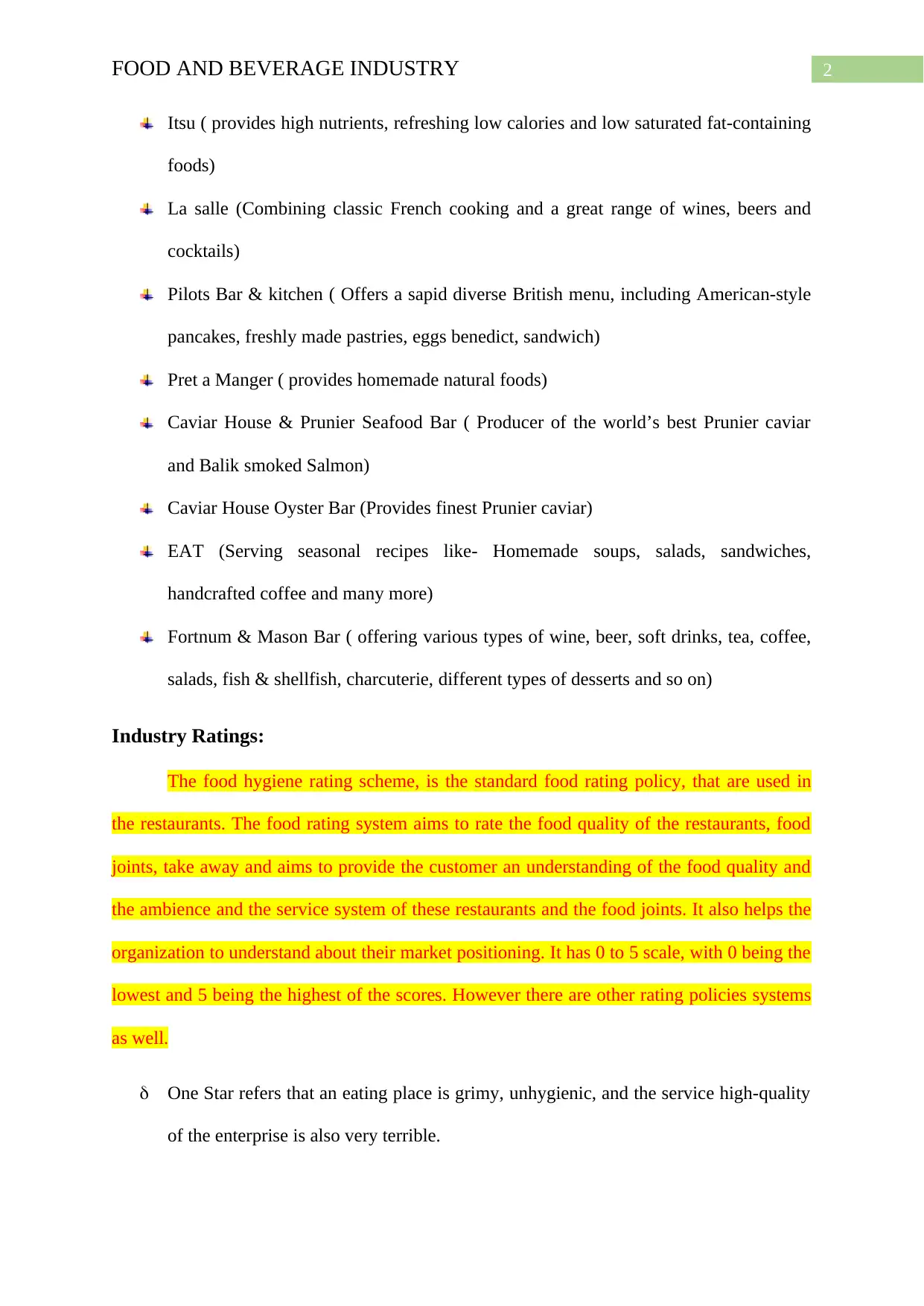
2FOOD AND BEVERAGE INDUSTRY
Itsu ( provides high nutrients, refreshing low calories and low saturated fat-containing
foods)
La salle (Combining classic French cooking and a great range of wines, beers and
cocktails)
Pilots Bar & kitchen ( Offers a sapid diverse British menu, including American-style
pancakes, freshly made pastries, eggs benedict, sandwich)
Pret a Manger ( provides homemade natural foods)
Caviar House & Prunier Seafood Bar ( Producer of the world’s best Prunier caviar
and Balik smoked Salmon)
Caviar House Oyster Bar (Provides finest Prunier caviar)
EAT (Serving seasonal recipes like- Homemade soups, salads, sandwiches,
handcrafted coffee and many more)
Fortnum & Mason Bar ( offering various types of wine, beer, soft drinks, tea, coffee,
salads, fish & shellfish, charcuterie, different types of desserts and so on)
Industry Ratings:
The food hygiene rating scheme, is the standard food rating policy, that are used in
the restaurants. The food rating system aims to rate the food quality of the restaurants, food
joints, take away and aims to provide the customer an understanding of the food quality and
the ambience and the service system of these restaurants and the food joints. It also helps the
organization to understand about their market positioning. It has 0 to 5 scale, with 0 being the
lowest and 5 being the highest of the scores. However there are other rating policies systems
as well.
One Star refers that an eating place is grimy, unhygienic, and the service high-quality
of the enterprise is also very terrible.
Itsu ( provides high nutrients, refreshing low calories and low saturated fat-containing
foods)
La salle (Combining classic French cooking and a great range of wines, beers and
cocktails)
Pilots Bar & kitchen ( Offers a sapid diverse British menu, including American-style
pancakes, freshly made pastries, eggs benedict, sandwich)
Pret a Manger ( provides homemade natural foods)
Caviar House & Prunier Seafood Bar ( Producer of the world’s best Prunier caviar
and Balik smoked Salmon)
Caviar House Oyster Bar (Provides finest Prunier caviar)
EAT (Serving seasonal recipes like- Homemade soups, salads, sandwiches,
handcrafted coffee and many more)
Fortnum & Mason Bar ( offering various types of wine, beer, soft drinks, tea, coffee,
salads, fish & shellfish, charcuterie, different types of desserts and so on)
Industry Ratings:
The food hygiene rating scheme, is the standard food rating policy, that are used in
the restaurants. The food rating system aims to rate the food quality of the restaurants, food
joints, take away and aims to provide the customer an understanding of the food quality and
the ambience and the service system of these restaurants and the food joints. It also helps the
organization to understand about their market positioning. It has 0 to 5 scale, with 0 being the
lowest and 5 being the highest of the scores. However there are other rating policies systems
as well.
One Star refers that an eating place is grimy, unhygienic, and the service high-quality
of the enterprise is also very terrible.
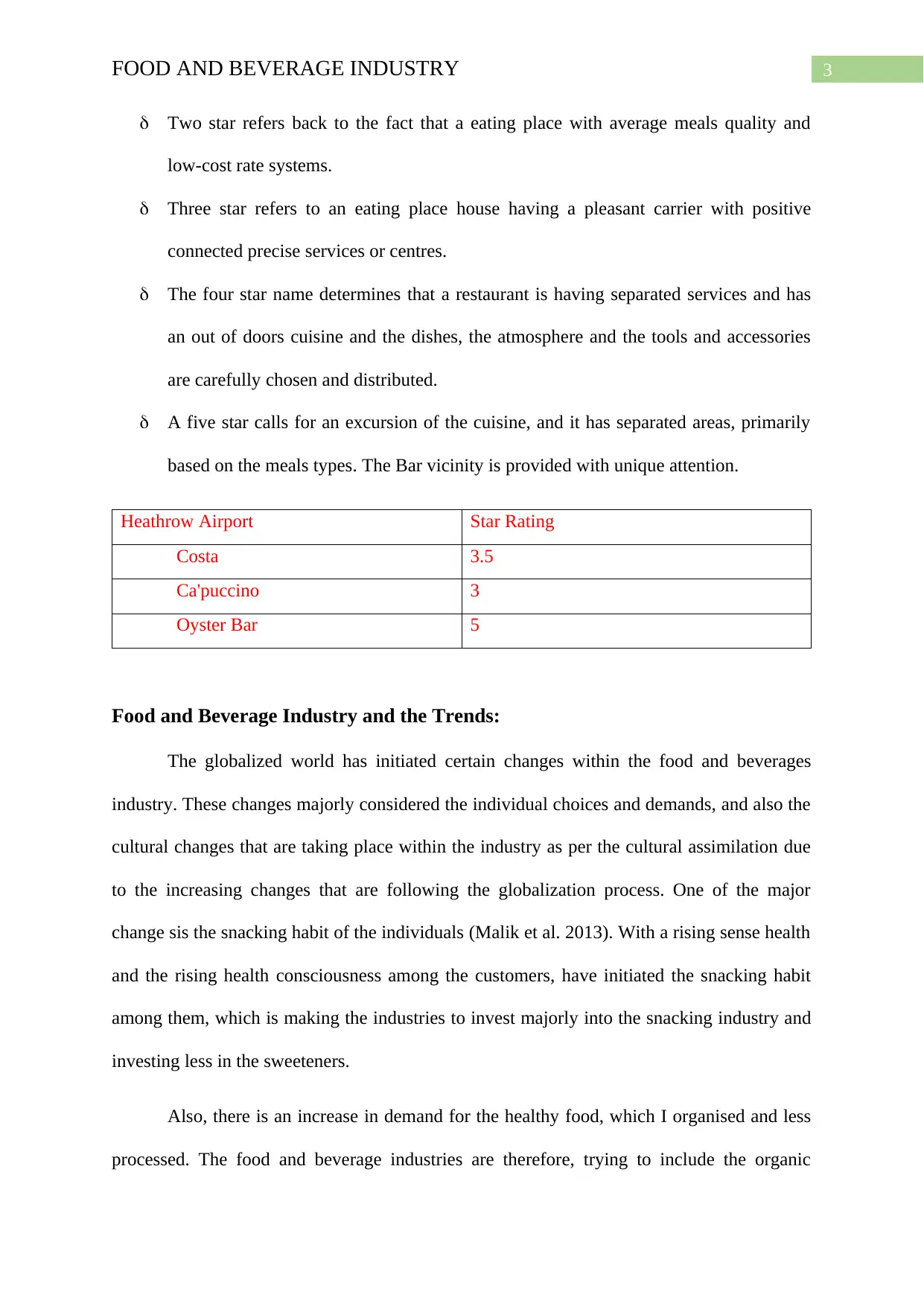
3FOOD AND BEVERAGE INDUSTRY
Two star refers back to the fact that a eating place with average meals quality and
low-cost rate systems.
Three star refers to an eating place house having a pleasant carrier with positive
connected precise services or centres.
The four star name determines that a restaurant is having separated services and has
an out of doors cuisine and the dishes, the atmosphere and the tools and accessories
are carefully chosen and distributed.
A five star calls for an excursion of the cuisine, and it has separated areas, primarily
based on the meals types. The Bar vicinity is provided with unique attention.
Heathrow Airport Star Rating
Costa 3.5
Ca'puccino 3
Oyster Bar 5
Food and Beverage Industry and the Trends:
The globalized world has initiated certain changes within the food and beverages
industry. These changes majorly considered the individual choices and demands, and also the
cultural changes that are taking place within the industry as per the cultural assimilation due
to the increasing changes that are following the globalization process. One of the major
change sis the snacking habit of the individuals (Malik et al. 2013). With a rising sense health
and the rising health consciousness among the customers, have initiated the snacking habit
among them, which is making the industries to invest majorly into the snacking industry and
investing less in the sweeteners.
Also, there is an increase in demand for the healthy food, which I organised and less
processed. The food and beverage industries are therefore, trying to include the organic
Two star refers back to the fact that a eating place with average meals quality and
low-cost rate systems.
Three star refers to an eating place house having a pleasant carrier with positive
connected precise services or centres.
The four star name determines that a restaurant is having separated services and has
an out of doors cuisine and the dishes, the atmosphere and the tools and accessories
are carefully chosen and distributed.
A five star calls for an excursion of the cuisine, and it has separated areas, primarily
based on the meals types. The Bar vicinity is provided with unique attention.
Heathrow Airport Star Rating
Costa 3.5
Ca'puccino 3
Oyster Bar 5
Food and Beverage Industry and the Trends:
The globalized world has initiated certain changes within the food and beverages
industry. These changes majorly considered the individual choices and demands, and also the
cultural changes that are taking place within the industry as per the cultural assimilation due
to the increasing changes that are following the globalization process. One of the major
change sis the snacking habit of the individuals (Malik et al. 2013). With a rising sense health
and the rising health consciousness among the customers, have initiated the snacking habit
among them, which is making the industries to invest majorly into the snacking industry and
investing less in the sweeteners.
Also, there is an increase in demand for the healthy food, which I organised and less
processed. The food and beverage industries are therefore, trying to include the organic
Secure Best Marks with AI Grader
Need help grading? Try our AI Grader for instant feedback on your assignments.
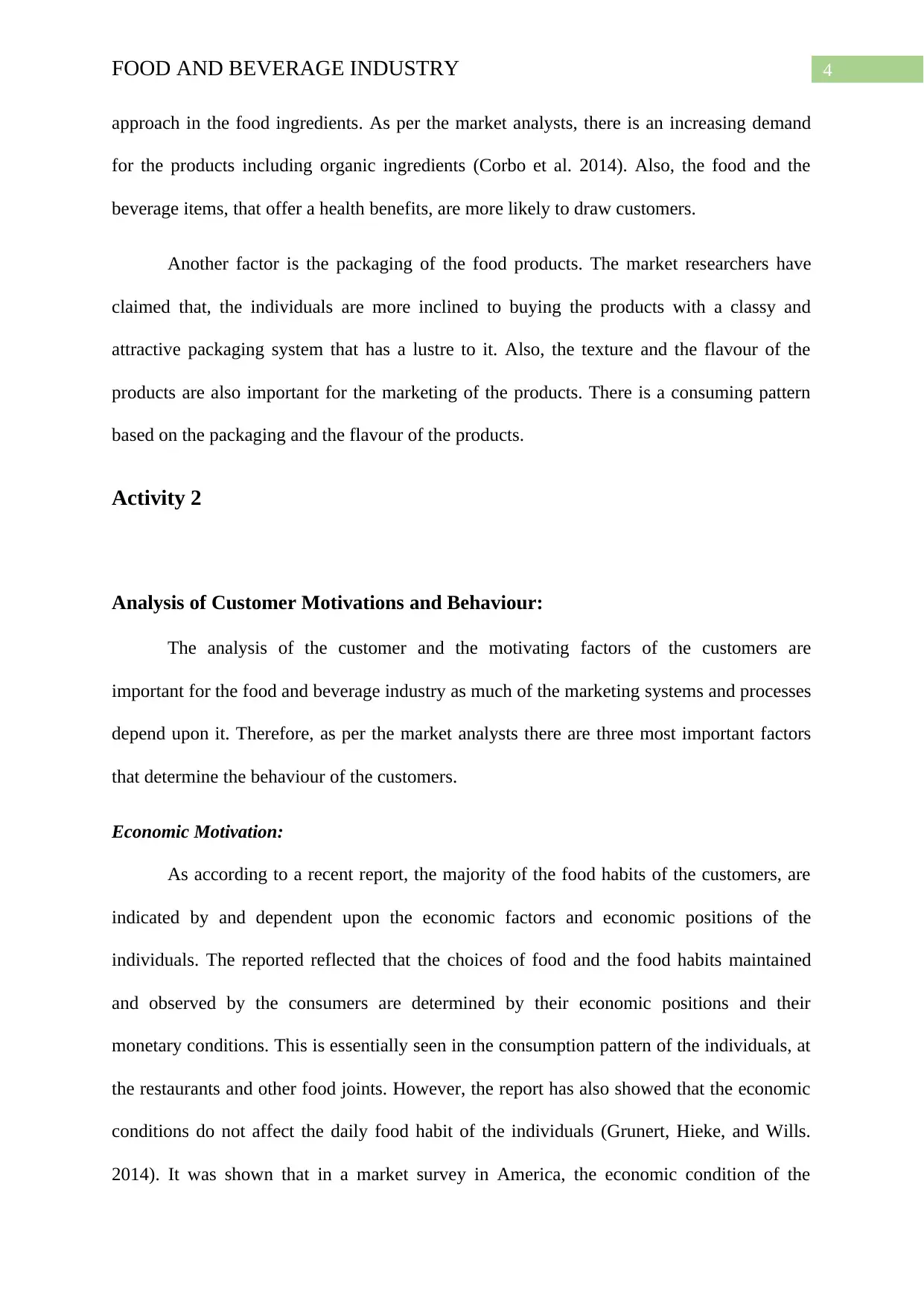
4FOOD AND BEVERAGE INDUSTRY
approach in the food ingredients. As per the market analysts, there is an increasing demand
for the products including organic ingredients (Corbo et al. 2014). Also, the food and the
beverage items, that offer a health benefits, are more likely to draw customers.
Another factor is the packaging of the food products. The market researchers have
claimed that, the individuals are more inclined to buying the products with a classy and
attractive packaging system that has a lustre to it. Also, the texture and the flavour of the
products are also important for the marketing of the products. There is a consuming pattern
based on the packaging and the flavour of the products.
Activity 2
Analysis of Customer Motivations and Behaviour:
The analysis of the customer and the motivating factors of the customers are
important for the food and beverage industry as much of the marketing systems and processes
depend upon it. Therefore, as per the market analysts there are three most important factors
that determine the behaviour of the customers.
Economic Motivation:
As according to a recent report, the majority of the food habits of the customers, are
indicated by and dependent upon the economic factors and economic positions of the
individuals. The reported reflected that the choices of food and the food habits maintained
and observed by the consumers are determined by their economic positions and their
monetary conditions. This is essentially seen in the consumption pattern of the individuals, at
the restaurants and other food joints. However, the report has also showed that the economic
conditions do not affect the daily food habit of the individuals (Grunert, Hieke, and Wills.
2014). It was shown that in a market survey in America, the economic condition of the
approach in the food ingredients. As per the market analysts, there is an increasing demand
for the products including organic ingredients (Corbo et al. 2014). Also, the food and the
beverage items, that offer a health benefits, are more likely to draw customers.
Another factor is the packaging of the food products. The market researchers have
claimed that, the individuals are more inclined to buying the products with a classy and
attractive packaging system that has a lustre to it. Also, the texture and the flavour of the
products are also important for the marketing of the products. There is a consuming pattern
based on the packaging and the flavour of the products.
Activity 2
Analysis of Customer Motivations and Behaviour:
The analysis of the customer and the motivating factors of the customers are
important for the food and beverage industry as much of the marketing systems and processes
depend upon it. Therefore, as per the market analysts there are three most important factors
that determine the behaviour of the customers.
Economic Motivation:
As according to a recent report, the majority of the food habits of the customers, are
indicated by and dependent upon the economic factors and economic positions of the
individuals. The reported reflected that the choices of food and the food habits maintained
and observed by the consumers are determined by their economic positions and their
monetary conditions. This is essentially seen in the consumption pattern of the individuals, at
the restaurants and other food joints. However, the report has also showed that the economic
conditions do not affect the daily food habit of the individuals (Grunert, Hieke, and Wills.
2014). It was shown that in a market survey in America, the economic condition of the
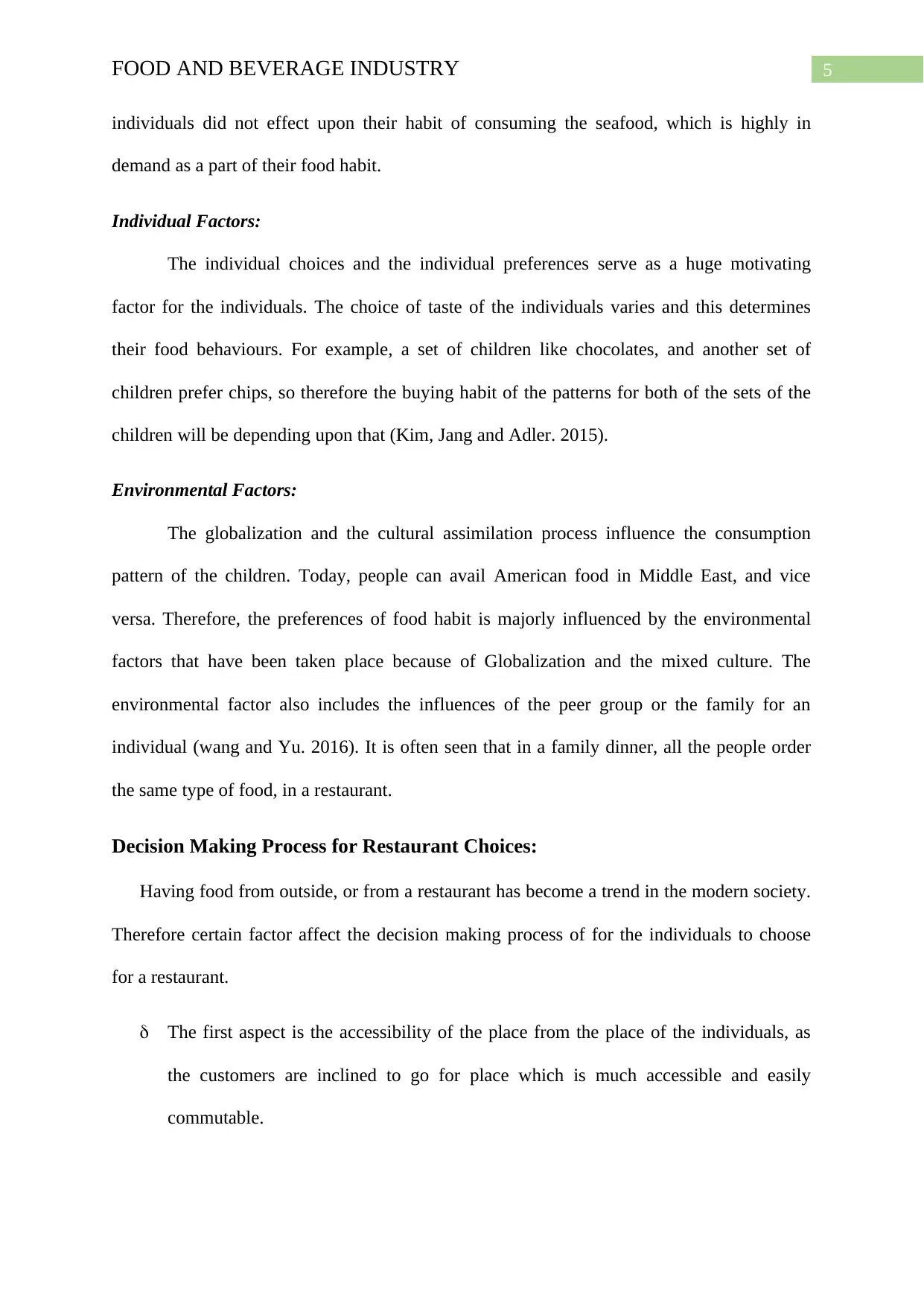
5FOOD AND BEVERAGE INDUSTRY
individuals did not effect upon their habit of consuming the seafood, which is highly in
demand as a part of their food habit.
Individual Factors:
The individual choices and the individual preferences serve as a huge motivating
factor for the individuals. The choice of taste of the individuals varies and this determines
their food behaviours. For example, a set of children like chocolates, and another set of
children prefer chips, so therefore the buying habit of the patterns for both of the sets of the
children will be depending upon that (Kim, Jang and Adler. 2015).
Environmental Factors:
The globalization and the cultural assimilation process influence the consumption
pattern of the children. Today, people can avail American food in Middle East, and vice
versa. Therefore, the preferences of food habit is majorly influenced by the environmental
factors that have been taken place because of Globalization and the mixed culture. The
environmental factor also includes the influences of the peer group or the family for an
individual (wang and Yu. 2016). It is often seen that in a family dinner, all the people order
the same type of food, in a restaurant.
Decision Making Process for Restaurant Choices:
Having food from outside, or from a restaurant has become a trend in the modern society.
Therefore certain factor affect the decision making process of for the individuals to choose
for a restaurant.
The first aspect is the accessibility of the place from the place of the individuals, as
the customers are inclined to go for place which is much accessible and easily
commutable.
individuals did not effect upon their habit of consuming the seafood, which is highly in
demand as a part of their food habit.
Individual Factors:
The individual choices and the individual preferences serve as a huge motivating
factor for the individuals. The choice of taste of the individuals varies and this determines
their food behaviours. For example, a set of children like chocolates, and another set of
children prefer chips, so therefore the buying habit of the patterns for both of the sets of the
children will be depending upon that (Kim, Jang and Adler. 2015).
Environmental Factors:
The globalization and the cultural assimilation process influence the consumption
pattern of the children. Today, people can avail American food in Middle East, and vice
versa. Therefore, the preferences of food habit is majorly influenced by the environmental
factors that have been taken place because of Globalization and the mixed culture. The
environmental factor also includes the influences of the peer group or the family for an
individual (wang and Yu. 2016). It is often seen that in a family dinner, all the people order
the same type of food, in a restaurant.
Decision Making Process for Restaurant Choices:
Having food from outside, or from a restaurant has become a trend in the modern society.
Therefore certain factor affect the decision making process of for the individuals to choose
for a restaurant.
The first aspect is the accessibility of the place from the place of the individuals, as
the customers are inclined to go for place which is much accessible and easily
commutable.
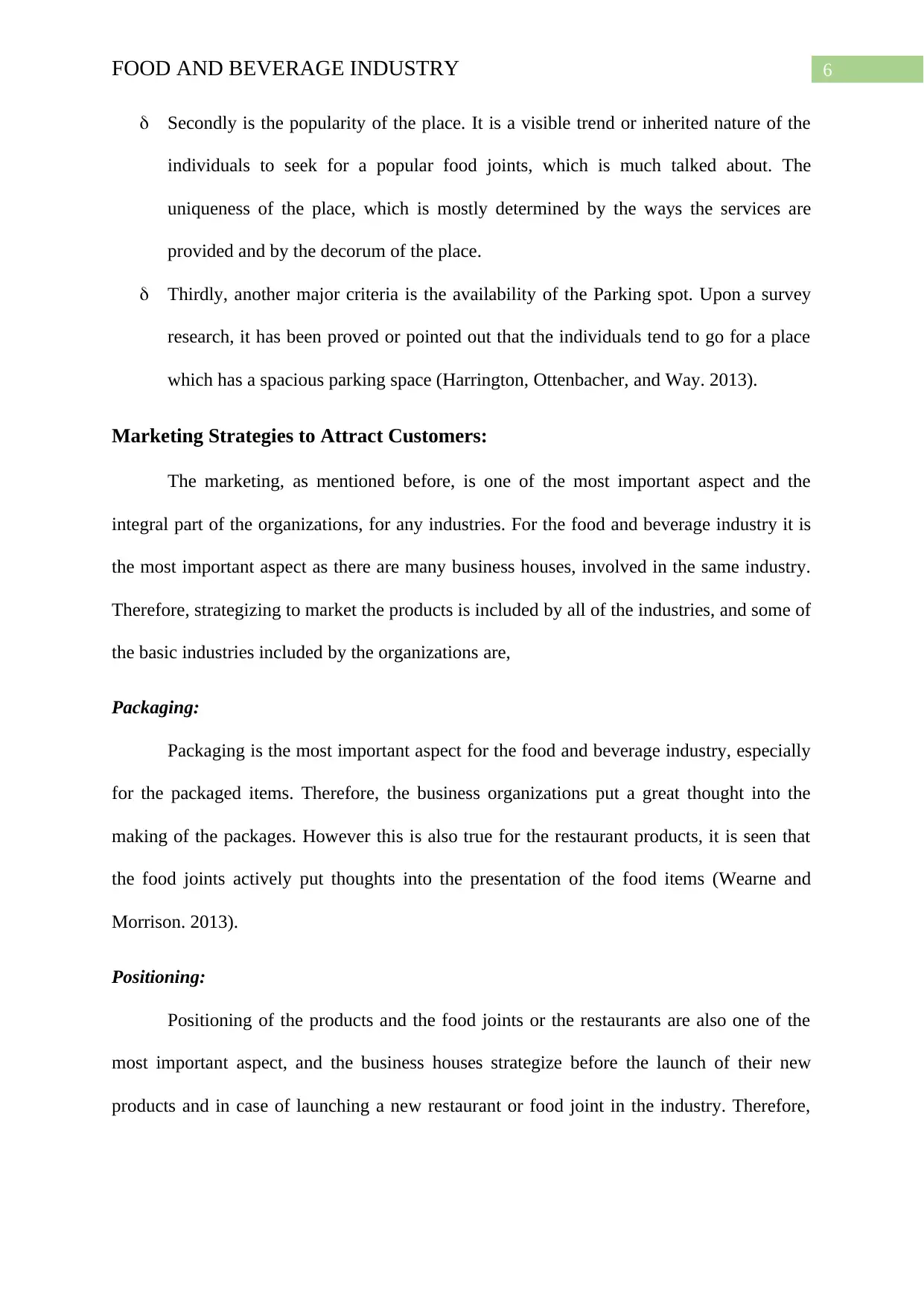
6FOOD AND BEVERAGE INDUSTRY
Secondly is the popularity of the place. It is a visible trend or inherited nature of the
individuals to seek for a popular food joints, which is much talked about. The
uniqueness of the place, which is mostly determined by the ways the services are
provided and by the decorum of the place.
Thirdly, another major criteria is the availability of the Parking spot. Upon a survey
research, it has been proved or pointed out that the individuals tend to go for a place
which has a spacious parking space (Harrington, Ottenbacher, and Way. 2013).
Marketing Strategies to Attract Customers:
The marketing, as mentioned before, is one of the most important aspect and the
integral part of the organizations, for any industries. For the food and beverage industry it is
the most important aspect as there are many business houses, involved in the same industry.
Therefore, strategizing to market the products is included by all of the industries, and some of
the basic industries included by the organizations are,
Packaging:
Packaging is the most important aspect for the food and beverage industry, especially
for the packaged items. Therefore, the business organizations put a great thought into the
making of the packages. However this is also true for the restaurant products, it is seen that
the food joints actively put thoughts into the presentation of the food items (Wearne and
Morrison. 2013).
Positioning:
Positioning of the products and the food joints or the restaurants are also one of the
most important aspect, and the business houses strategize before the launch of their new
products and in case of launching a new restaurant or food joint in the industry. Therefore,
Secondly is the popularity of the place. It is a visible trend or inherited nature of the
individuals to seek for a popular food joints, which is much talked about. The
uniqueness of the place, which is mostly determined by the ways the services are
provided and by the decorum of the place.
Thirdly, another major criteria is the availability of the Parking spot. Upon a survey
research, it has been proved or pointed out that the individuals tend to go for a place
which has a spacious parking space (Harrington, Ottenbacher, and Way. 2013).
Marketing Strategies to Attract Customers:
The marketing, as mentioned before, is one of the most important aspect and the
integral part of the organizations, for any industries. For the food and beverage industry it is
the most important aspect as there are many business houses, involved in the same industry.
Therefore, strategizing to market the products is included by all of the industries, and some of
the basic industries included by the organizations are,
Packaging:
Packaging is the most important aspect for the food and beverage industry, especially
for the packaged items. Therefore, the business organizations put a great thought into the
making of the packages. However this is also true for the restaurant products, it is seen that
the food joints actively put thoughts into the presentation of the food items (Wearne and
Morrison. 2013).
Positioning:
Positioning of the products and the food joints or the restaurants are also one of the
most important aspect, and the business houses strategize before the launch of their new
products and in case of launching a new restaurant or food joint in the industry. Therefore,
Paraphrase This Document
Need a fresh take? Get an instant paraphrase of this document with our AI Paraphraser
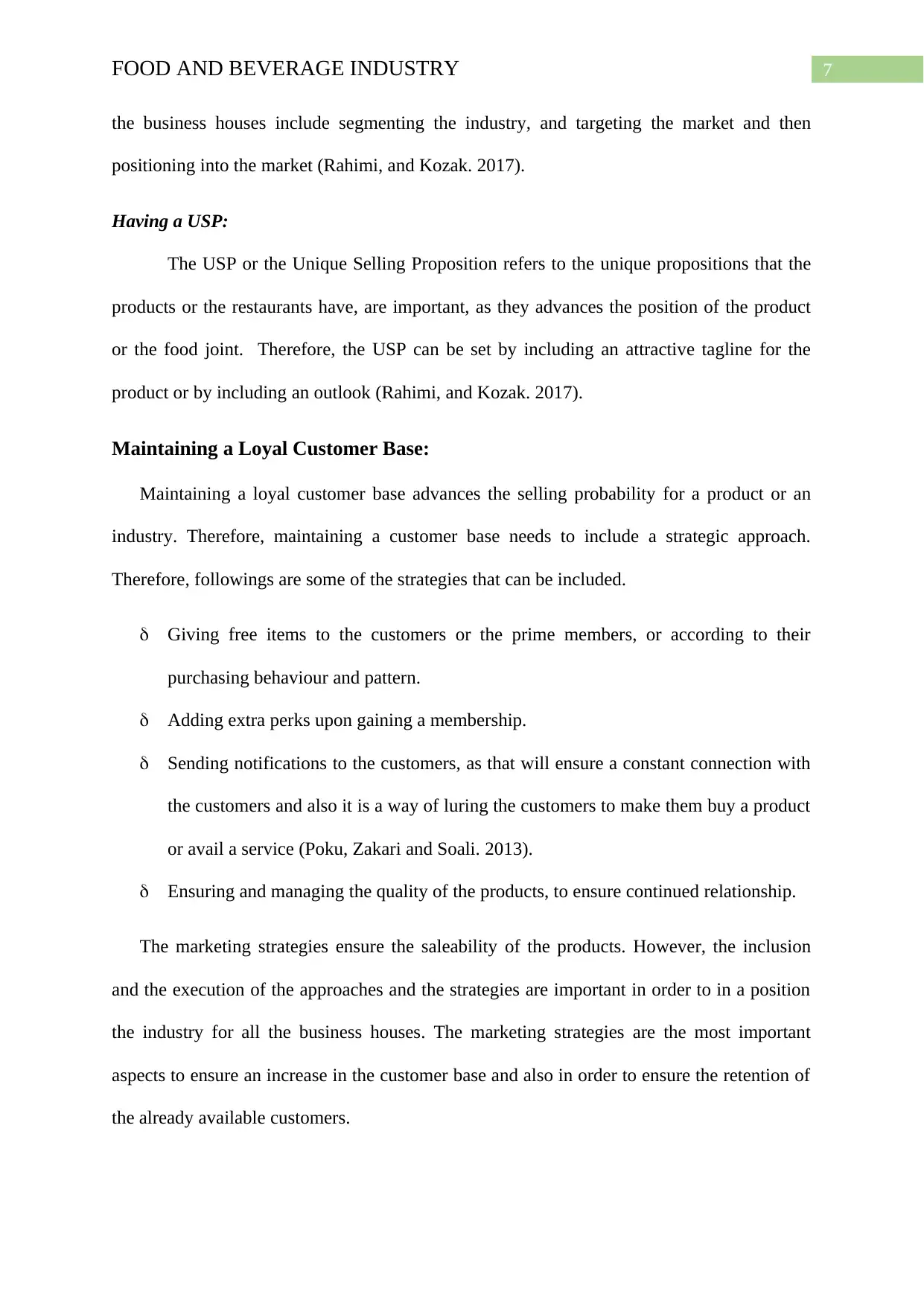
7FOOD AND BEVERAGE INDUSTRY
the business houses include segmenting the industry, and targeting the market and then
positioning into the market (Rahimi, and Kozak. 2017).
Having a USP:
The USP or the Unique Selling Proposition refers to the unique propositions that the
products or the restaurants have, are important, as they advances the position of the product
or the food joint. Therefore, the USP can be set by including an attractive tagline for the
product or by including an outlook (Rahimi, and Kozak. 2017).
Maintaining a Loyal Customer Base:
Maintaining a loyal customer base advances the selling probability for a product or an
industry. Therefore, maintaining a customer base needs to include a strategic approach.
Therefore, followings are some of the strategies that can be included.
Giving free items to the customers or the prime members, or according to their
purchasing behaviour and pattern.
Adding extra perks upon gaining a membership.
Sending notifications to the customers, as that will ensure a constant connection with
the customers and also it is a way of luring the customers to make them buy a product
or avail a service (Poku, Zakari and Soali. 2013).
Ensuring and managing the quality of the products, to ensure continued relationship.
The marketing strategies ensure the saleability of the products. However, the inclusion
and the execution of the approaches and the strategies are important in order to in a position
the industry for all the business houses. The marketing strategies are the most important
aspects to ensure an increase in the customer base and also in order to ensure the retention of
the already available customers.
the business houses include segmenting the industry, and targeting the market and then
positioning into the market (Rahimi, and Kozak. 2017).
Having a USP:
The USP or the Unique Selling Proposition refers to the unique propositions that the
products or the restaurants have, are important, as they advances the position of the product
or the food joint. Therefore, the USP can be set by including an attractive tagline for the
product or by including an outlook (Rahimi, and Kozak. 2017).
Maintaining a Loyal Customer Base:
Maintaining a loyal customer base advances the selling probability for a product or an
industry. Therefore, maintaining a customer base needs to include a strategic approach.
Therefore, followings are some of the strategies that can be included.
Giving free items to the customers or the prime members, or according to their
purchasing behaviour and pattern.
Adding extra perks upon gaining a membership.
Sending notifications to the customers, as that will ensure a constant connection with
the customers and also it is a way of luring the customers to make them buy a product
or avail a service (Poku, Zakari and Soali. 2013).
Ensuring and managing the quality of the products, to ensure continued relationship.
The marketing strategies ensure the saleability of the products. However, the inclusion
and the execution of the approaches and the strategies are important in order to in a position
the industry for all the business houses. The marketing strategies are the most important
aspects to ensure an increase in the customer base and also in order to ensure the retention of
the already available customers.
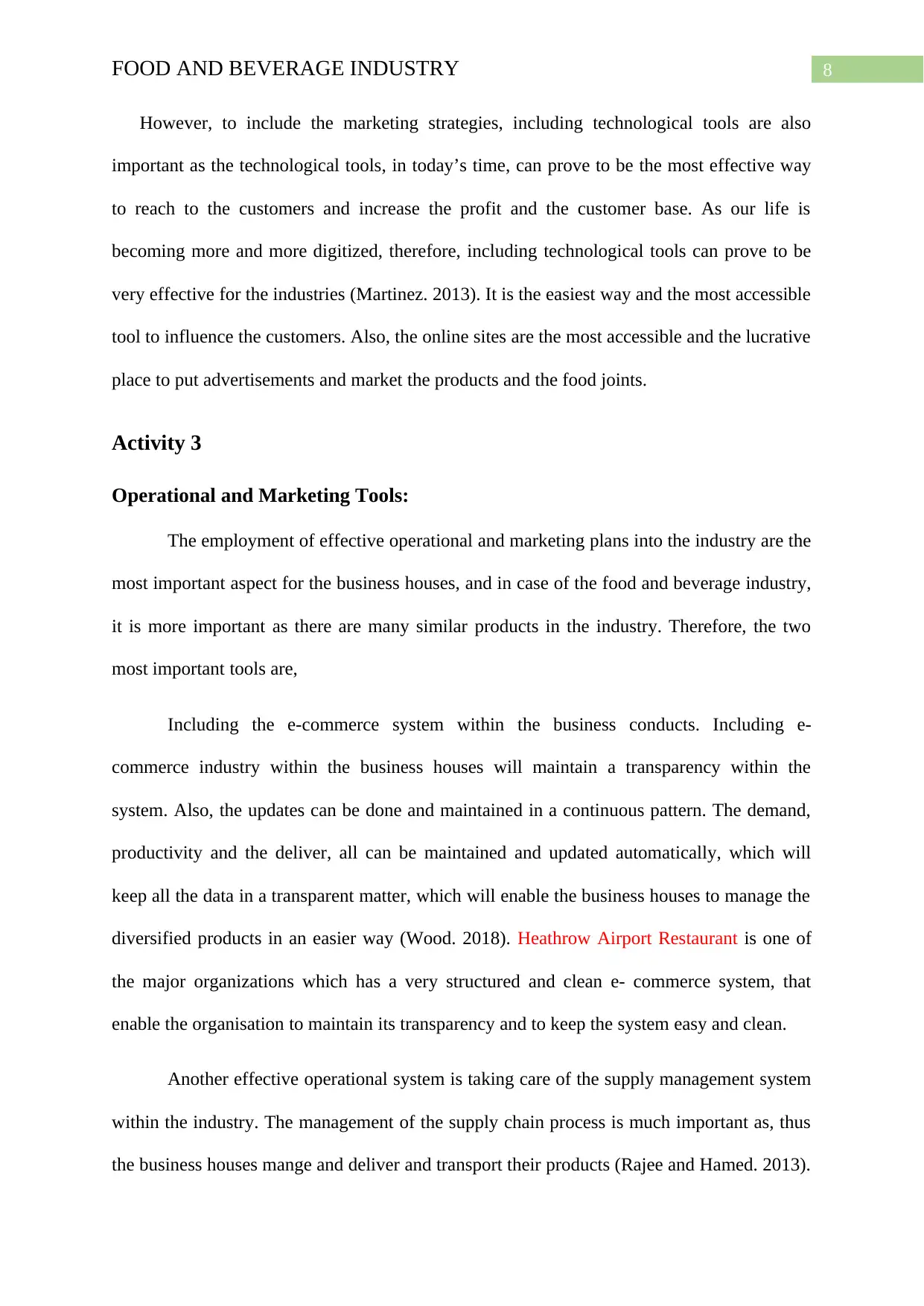
8FOOD AND BEVERAGE INDUSTRY
However, to include the marketing strategies, including technological tools are also
important as the technological tools, in today’s time, can prove to be the most effective way
to reach to the customers and increase the profit and the customer base. As our life is
becoming more and more digitized, therefore, including technological tools can prove to be
very effective for the industries (Martinez. 2013). It is the easiest way and the most accessible
tool to influence the customers. Also, the online sites are the most accessible and the lucrative
place to put advertisements and market the products and the food joints.
Activity 3
Operational and Marketing Tools:
The employment of effective operational and marketing plans into the industry are the
most important aspect for the business houses, and in case of the food and beverage industry,
it is more important as there are many similar products in the industry. Therefore, the two
most important tools are,
Including the e-commerce system within the business conducts. Including e-
commerce industry within the business houses will maintain a transparency within the
system. Also, the updates can be done and maintained in a continuous pattern. The demand,
productivity and the deliver, all can be maintained and updated automatically, which will
keep all the data in a transparent matter, which will enable the business houses to manage the
diversified products in an easier way (Wood. 2018). Heathrow Airport Restaurant is one of
the major organizations which has a very structured and clean e- commerce system, that
enable the organisation to maintain its transparency and to keep the system easy and clean.
Another effective operational system is taking care of the supply management system
within the industry. The management of the supply chain process is much important as, thus
the business houses mange and deliver and transport their products (Rajee and Hamed. 2013).
However, to include the marketing strategies, including technological tools are also
important as the technological tools, in today’s time, can prove to be the most effective way
to reach to the customers and increase the profit and the customer base. As our life is
becoming more and more digitized, therefore, including technological tools can prove to be
very effective for the industries (Martinez. 2013). It is the easiest way and the most accessible
tool to influence the customers. Also, the online sites are the most accessible and the lucrative
place to put advertisements and market the products and the food joints.
Activity 3
Operational and Marketing Tools:
The employment of effective operational and marketing plans into the industry are the
most important aspect for the business houses, and in case of the food and beverage industry,
it is more important as there are many similar products in the industry. Therefore, the two
most important tools are,
Including the e-commerce system within the business conducts. Including e-
commerce industry within the business houses will maintain a transparency within the
system. Also, the updates can be done and maintained in a continuous pattern. The demand,
productivity and the deliver, all can be maintained and updated automatically, which will
keep all the data in a transparent matter, which will enable the business houses to manage the
diversified products in an easier way (Wood. 2018). Heathrow Airport Restaurant is one of
the major organizations which has a very structured and clean e- commerce system, that
enable the organisation to maintain its transparency and to keep the system easy and clean.
Another effective operational system is taking care of the supply management system
within the industry. The management of the supply chain process is much important as, thus
the business houses mange and deliver and transport their products (Rajee and Hamed. 2013).
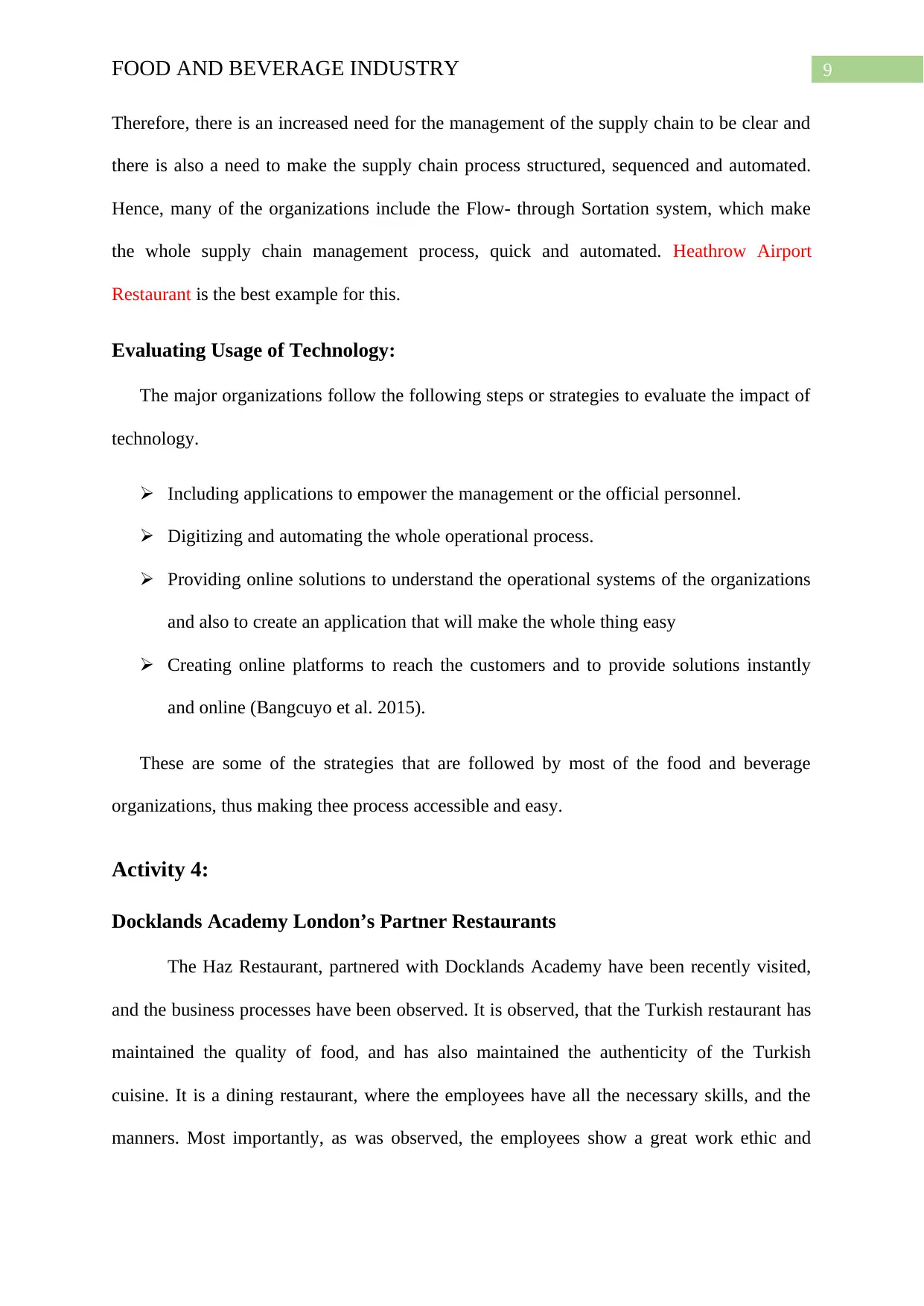
9FOOD AND BEVERAGE INDUSTRY
Therefore, there is an increased need for the management of the supply chain to be clear and
there is also a need to make the supply chain process structured, sequenced and automated.
Hence, many of the organizations include the Flow- through Sortation system, which make
the whole supply chain management process, quick and automated. Heathrow Airport
Restaurant is the best example for this.
Evaluating Usage of Technology:
The major organizations follow the following steps or strategies to evaluate the impact of
technology.
Including applications to empower the management or the official personnel.
Digitizing and automating the whole operational process.
Providing online solutions to understand the operational systems of the organizations
and also to create an application that will make the whole thing easy
Creating online platforms to reach the customers and to provide solutions instantly
and online (Bangcuyo et al. 2015).
These are some of the strategies that are followed by most of the food and beverage
organizations, thus making thee process accessible and easy.
Activity 4:
Docklands Academy London’s Partner Restaurants
The Haz Restaurant, partnered with Docklands Academy have been recently visited,
and the business processes have been observed. It is observed, that the Turkish restaurant has
maintained the quality of food, and has also maintained the authenticity of the Turkish
cuisine. It is a dining restaurant, where the employees have all the necessary skills, and the
manners. Most importantly, as was observed, the employees show a great work ethic and
Therefore, there is an increased need for the management of the supply chain to be clear and
there is also a need to make the supply chain process structured, sequenced and automated.
Hence, many of the organizations include the Flow- through Sortation system, which make
the whole supply chain management process, quick and automated. Heathrow Airport
Restaurant is the best example for this.
Evaluating Usage of Technology:
The major organizations follow the following steps or strategies to evaluate the impact of
technology.
Including applications to empower the management or the official personnel.
Digitizing and automating the whole operational process.
Providing online solutions to understand the operational systems of the organizations
and also to create an application that will make the whole thing easy
Creating online platforms to reach the customers and to provide solutions instantly
and online (Bangcuyo et al. 2015).
These are some of the strategies that are followed by most of the food and beverage
organizations, thus making thee process accessible and easy.
Activity 4:
Docklands Academy London’s Partner Restaurants
The Haz Restaurant, partnered with Docklands Academy have been recently visited,
and the business processes have been observed. It is observed, that the Turkish restaurant has
maintained the quality of food, and has also maintained the authenticity of the Turkish
cuisine. It is a dining restaurant, where the employees have all the necessary skills, and the
manners. Most importantly, as was observed, the employees show a great work ethic and
Secure Best Marks with AI Grader
Need help grading? Try our AI Grader for instant feedback on your assignments.
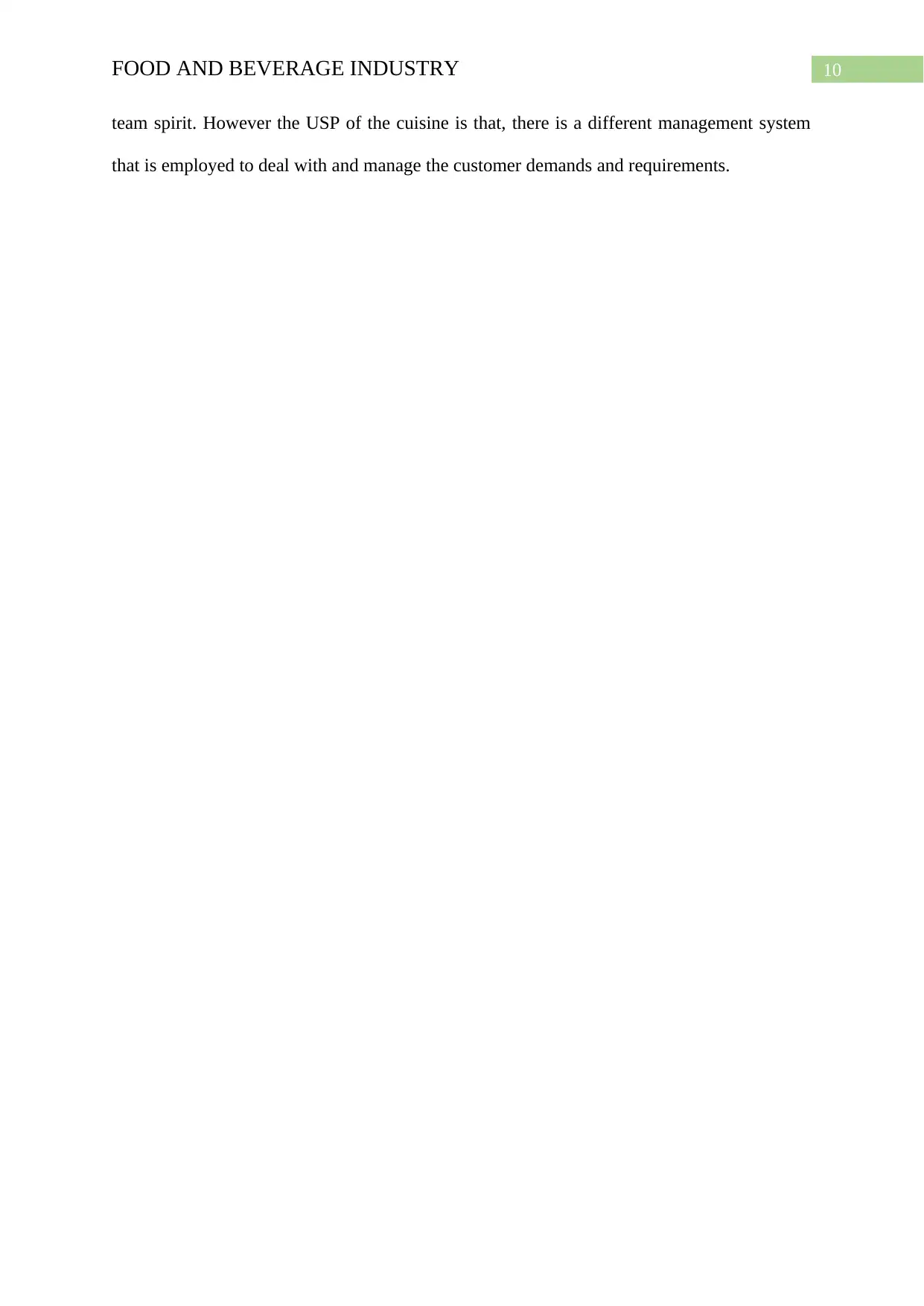
10FOOD AND BEVERAGE INDUSTRY
team spirit. However the USP of the cuisine is that, there is a different management system
that is employed to deal with and manage the customer demands and requirements.
team spirit. However the USP of the cuisine is that, there is a different management system
that is employed to deal with and manage the customer demands and requirements.
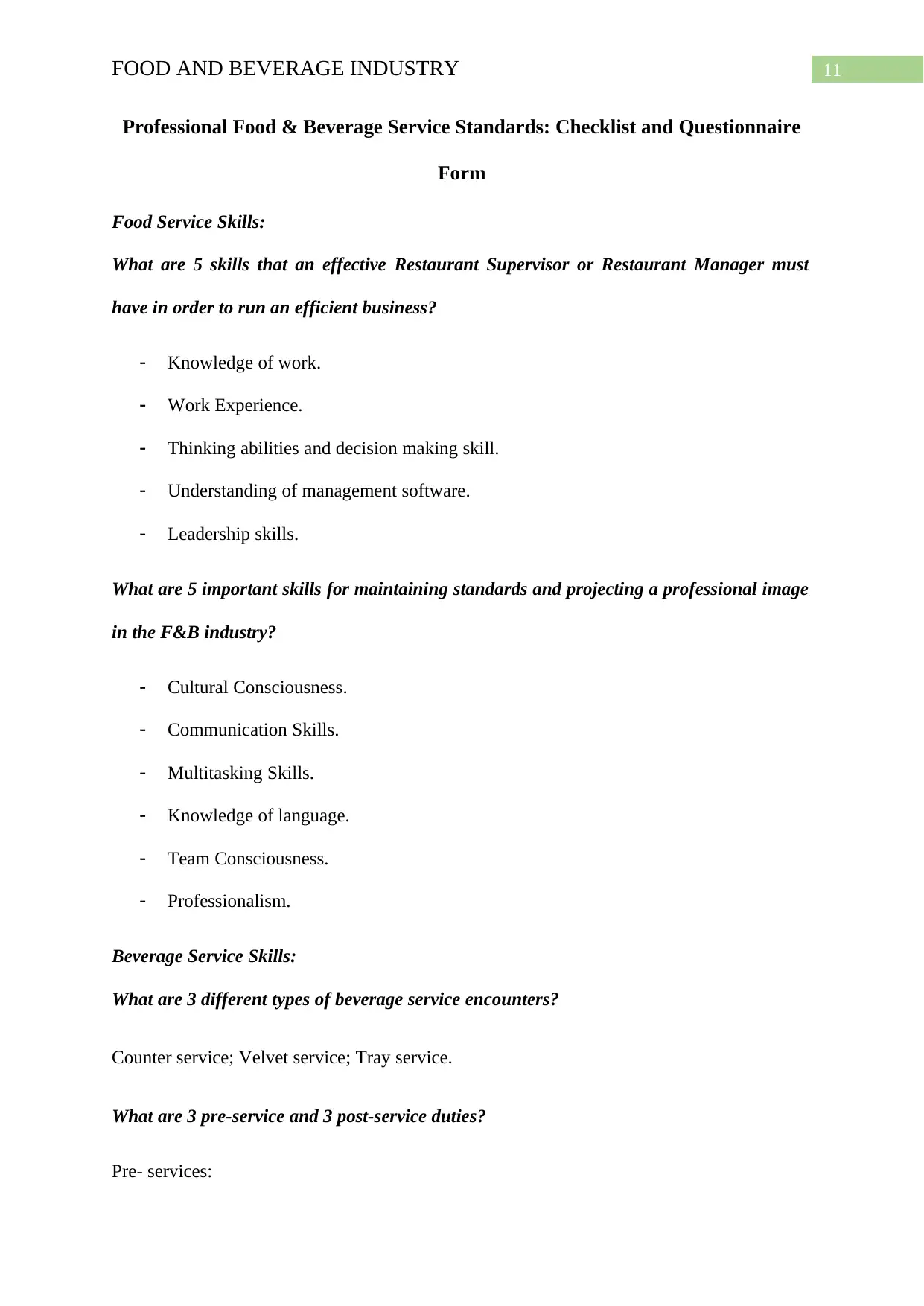
11FOOD AND BEVERAGE INDUSTRY
Professional Food & Beverage Service Standards: Checklist and Questionnaire
Form
Food Service Skills:
What are 5 skills that an effective Restaurant Supervisor or Restaurant Manager must
have in order to run an efficient business?
Knowledge of work.
Work Experience.
Thinking abilities and decision making skill.
Understanding of management software.
Leadership skills.
What are 5 important skills for maintaining standards and projecting a professional image
in the F&B industry?
Cultural Consciousness.
Communication Skills.
Multitasking Skills.
Knowledge of language.
Team Consciousness.
Professionalism.
Beverage Service Skills:
What are 3 different types of beverage service encounters?
Counter service; Velvet service; Tray service.
What are 3 pre-service and 3 post-service duties?
Pre- services:
Professional Food & Beverage Service Standards: Checklist and Questionnaire
Form
Food Service Skills:
What are 5 skills that an effective Restaurant Supervisor or Restaurant Manager must
have in order to run an efficient business?
Knowledge of work.
Work Experience.
Thinking abilities and decision making skill.
Understanding of management software.
Leadership skills.
What are 5 important skills for maintaining standards and projecting a professional image
in the F&B industry?
Cultural Consciousness.
Communication Skills.
Multitasking Skills.
Knowledge of language.
Team Consciousness.
Professionalism.
Beverage Service Skills:
What are 3 different types of beverage service encounters?
Counter service; Velvet service; Tray service.
What are 3 pre-service and 3 post-service duties?
Pre- services:
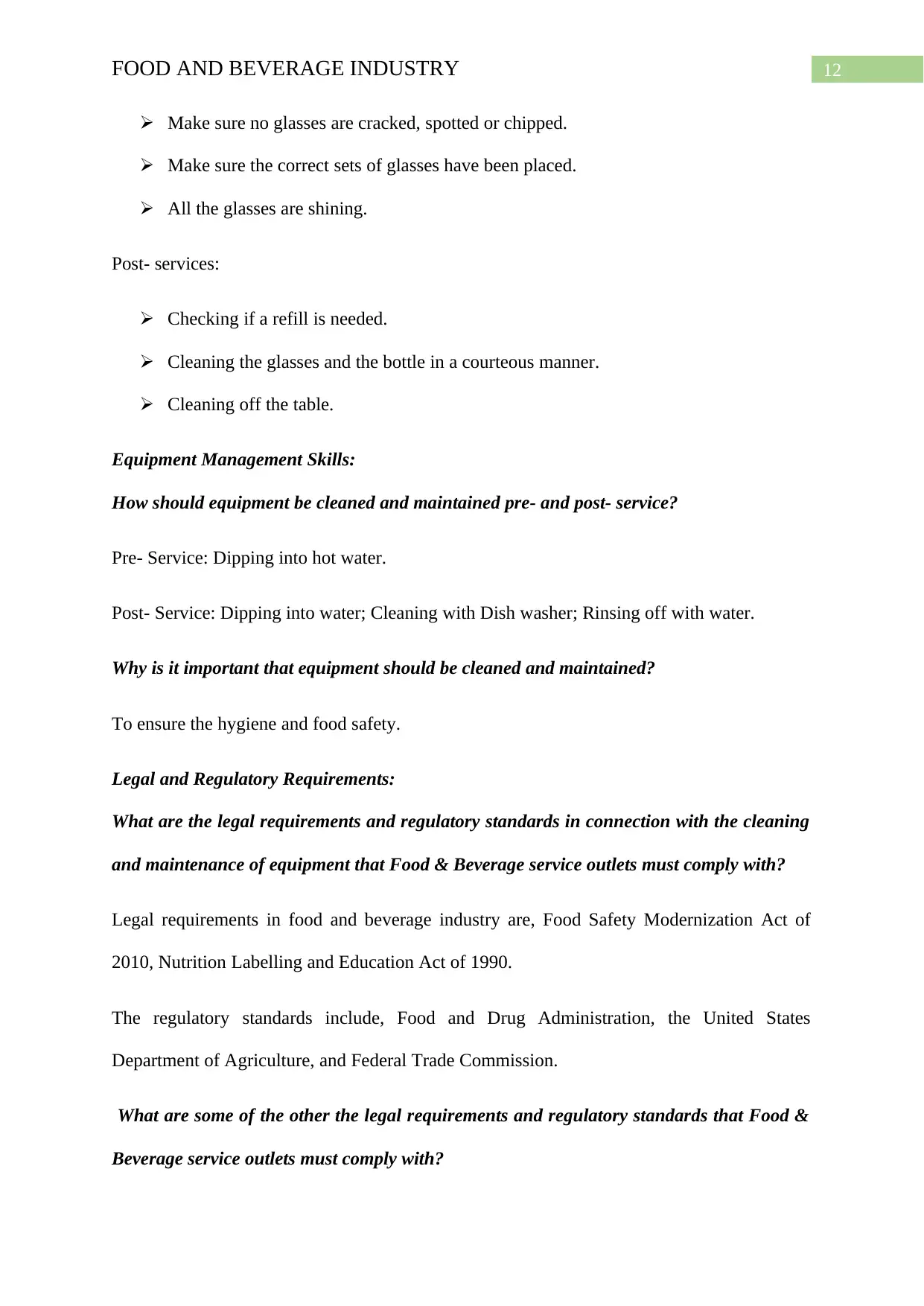
12FOOD AND BEVERAGE INDUSTRY
Make sure no glasses are cracked, spotted or chipped.
Make sure the correct sets of glasses have been placed.
All the glasses are shining.
Post- services:
Checking if a refill is needed.
Cleaning the glasses and the bottle in a courteous manner.
Cleaning off the table.
Equipment Management Skills:
How should equipment be cleaned and maintained pre- and post- service?
Pre- Service: Dipping into hot water.
Post- Service: Dipping into water; Cleaning with Dish washer; Rinsing off with water.
Why is it important that equipment should be cleaned and maintained?
To ensure the hygiene and food safety.
Legal and Regulatory Requirements:
What are the legal requirements and regulatory standards in connection with the cleaning
and maintenance of equipment that Food & Beverage service outlets must comply with?
Legal requirements in food and beverage industry are, Food Safety Modernization Act of
2010, Nutrition Labelling and Education Act of 1990.
The regulatory standards include, Food and Drug Administration, the United States
Department of Agriculture, and Federal Trade Commission.
What are some of the other the legal requirements and regulatory standards that Food &
Beverage service outlets must comply with?
Make sure no glasses are cracked, spotted or chipped.
Make sure the correct sets of glasses have been placed.
All the glasses are shining.
Post- services:
Checking if a refill is needed.
Cleaning the glasses and the bottle in a courteous manner.
Cleaning off the table.
Equipment Management Skills:
How should equipment be cleaned and maintained pre- and post- service?
Pre- Service: Dipping into hot water.
Post- Service: Dipping into water; Cleaning with Dish washer; Rinsing off with water.
Why is it important that equipment should be cleaned and maintained?
To ensure the hygiene and food safety.
Legal and Regulatory Requirements:
What are the legal requirements and regulatory standards in connection with the cleaning
and maintenance of equipment that Food & Beverage service outlets must comply with?
Legal requirements in food and beverage industry are, Food Safety Modernization Act of
2010, Nutrition Labelling and Education Act of 1990.
The regulatory standards include, Food and Drug Administration, the United States
Department of Agriculture, and Federal Trade Commission.
What are some of the other the legal requirements and regulatory standards that Food &
Beverage service outlets must comply with?
Paraphrase This Document
Need a fresh take? Get an instant paraphrase of this document with our AI Paraphraser
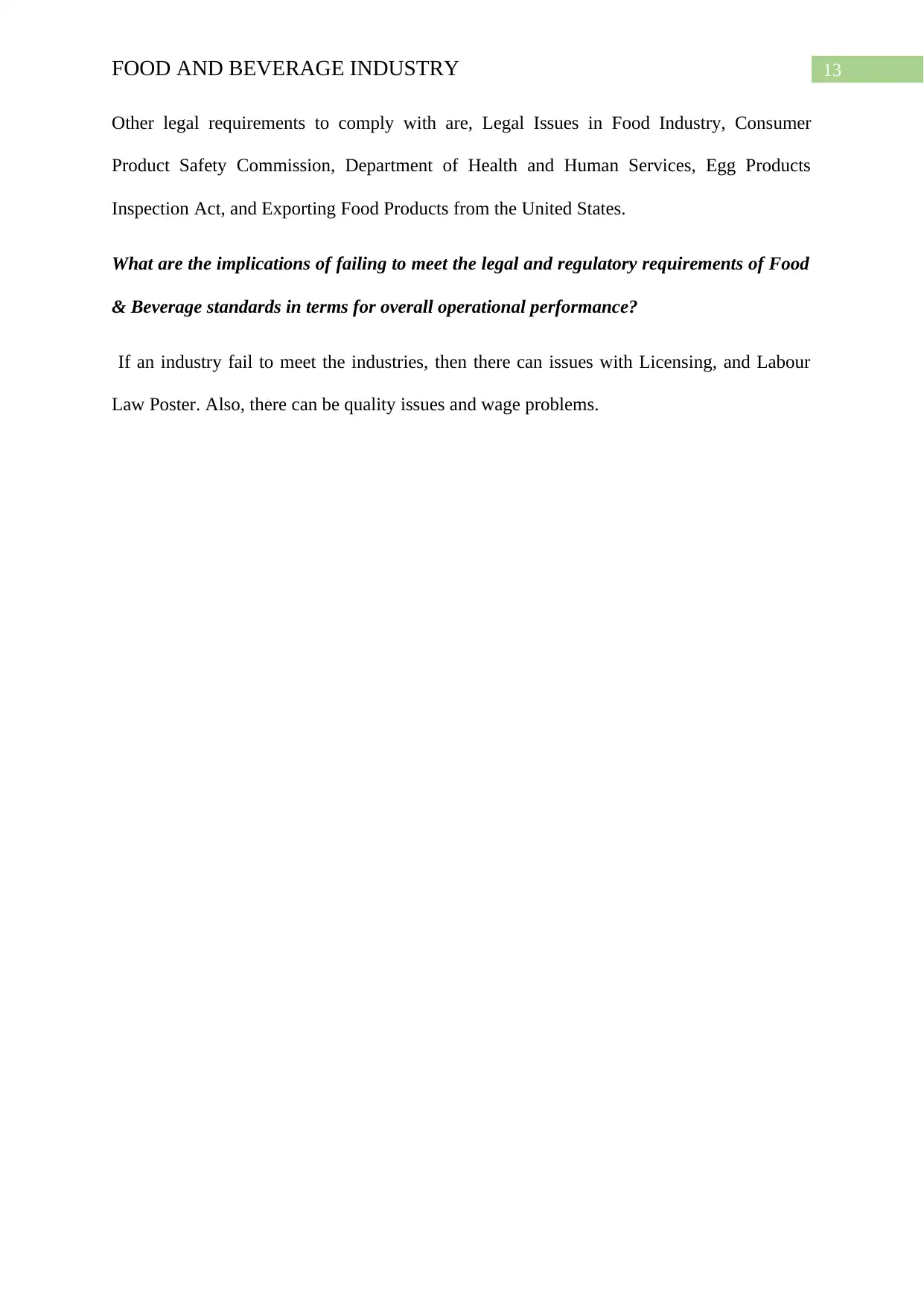
13FOOD AND BEVERAGE INDUSTRY
Other legal requirements to comply with are, Legal Issues in Food Industry, Consumer
Product Safety Commission, Department of Health and Human Services, Egg Products
Inspection Act, and Exporting Food Products from the United States.
What are the implications of failing to meet the legal and regulatory requirements of Food
& Beverage standards in terms for overall operational performance?
If an industry fail to meet the industries, then there can issues with Licensing, and Labour
Law Poster. Also, there can be quality issues and wage problems.
Other legal requirements to comply with are, Legal Issues in Food Industry, Consumer
Product Safety Commission, Department of Health and Human Services, Egg Products
Inspection Act, and Exporting Food Products from the United States.
What are the implications of failing to meet the legal and regulatory requirements of Food
& Beverage standards in terms for overall operational performance?
If an industry fail to meet the industries, then there can issues with Licensing, and Labour
Law Poster. Also, there can be quality issues and wage problems.
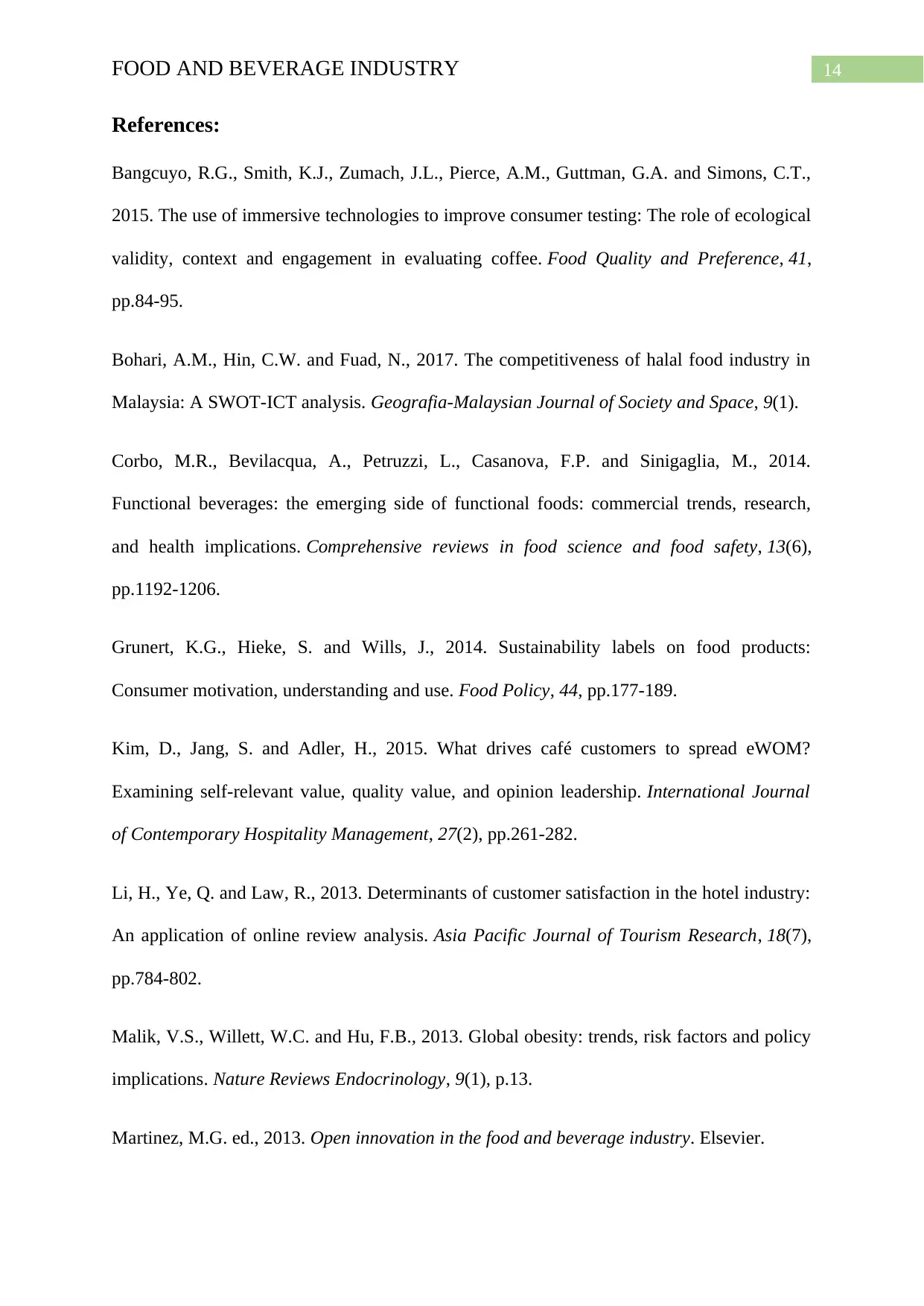
14FOOD AND BEVERAGE INDUSTRY
References:
Bangcuyo, R.G., Smith, K.J., Zumach, J.L., Pierce, A.M., Guttman, G.A. and Simons, C.T.,
2015. The use of immersive technologies to improve consumer testing: The role of ecological
validity, context and engagement in evaluating coffee. Food Quality and Preference, 41,
pp.84-95.
Bohari, A.M., Hin, C.W. and Fuad, N., 2017. The competitiveness of halal food industry in
Malaysia: A SWOT-ICT analysis. Geografia-Malaysian Journal of Society and Space, 9(1).
Corbo, M.R., Bevilacqua, A., Petruzzi, L., Casanova, F.P. and Sinigaglia, M., 2014.
Functional beverages: the emerging side of functional foods: commercial trends, research,
and health implications. Comprehensive reviews in food science and food safety, 13(6),
pp.1192-1206.
Grunert, K.G., Hieke, S. and Wills, J., 2014. Sustainability labels on food products:
Consumer motivation, understanding and use. Food Policy, 44, pp.177-189.
Kim, D., Jang, S. and Adler, H., 2015. What drives café customers to spread eWOM?
Examining self-relevant value, quality value, and opinion leadership. International Journal
of Contemporary Hospitality Management, 27(2), pp.261-282.
Li, H., Ye, Q. and Law, R., 2013. Determinants of customer satisfaction in the hotel industry:
An application of online review analysis. Asia Pacific Journal of Tourism Research, 18(7),
pp.784-802.
Malik, V.S., Willett, W.C. and Hu, F.B., 2013. Global obesity: trends, risk factors and policy
implications. Nature Reviews Endocrinology, 9(1), p.13.
Martinez, M.G. ed., 2013. Open innovation in the food and beverage industry. Elsevier.
References:
Bangcuyo, R.G., Smith, K.J., Zumach, J.L., Pierce, A.M., Guttman, G.A. and Simons, C.T.,
2015. The use of immersive technologies to improve consumer testing: The role of ecological
validity, context and engagement in evaluating coffee. Food Quality and Preference, 41,
pp.84-95.
Bohari, A.M., Hin, C.W. and Fuad, N., 2017. The competitiveness of halal food industry in
Malaysia: A SWOT-ICT analysis. Geografia-Malaysian Journal of Society and Space, 9(1).
Corbo, M.R., Bevilacqua, A., Petruzzi, L., Casanova, F.P. and Sinigaglia, M., 2014.
Functional beverages: the emerging side of functional foods: commercial trends, research,
and health implications. Comprehensive reviews in food science and food safety, 13(6),
pp.1192-1206.
Grunert, K.G., Hieke, S. and Wills, J., 2014. Sustainability labels on food products:
Consumer motivation, understanding and use. Food Policy, 44, pp.177-189.
Kim, D., Jang, S. and Adler, H., 2015. What drives café customers to spread eWOM?
Examining self-relevant value, quality value, and opinion leadership. International Journal
of Contemporary Hospitality Management, 27(2), pp.261-282.
Li, H., Ye, Q. and Law, R., 2013. Determinants of customer satisfaction in the hotel industry:
An application of online review analysis. Asia Pacific Journal of Tourism Research, 18(7),
pp.784-802.
Malik, V.S., Willett, W.C. and Hu, F.B., 2013. Global obesity: trends, risk factors and policy
implications. Nature Reviews Endocrinology, 9(1), p.13.
Martinez, M.G. ed., 2013. Open innovation in the food and beverage industry. Elsevier.
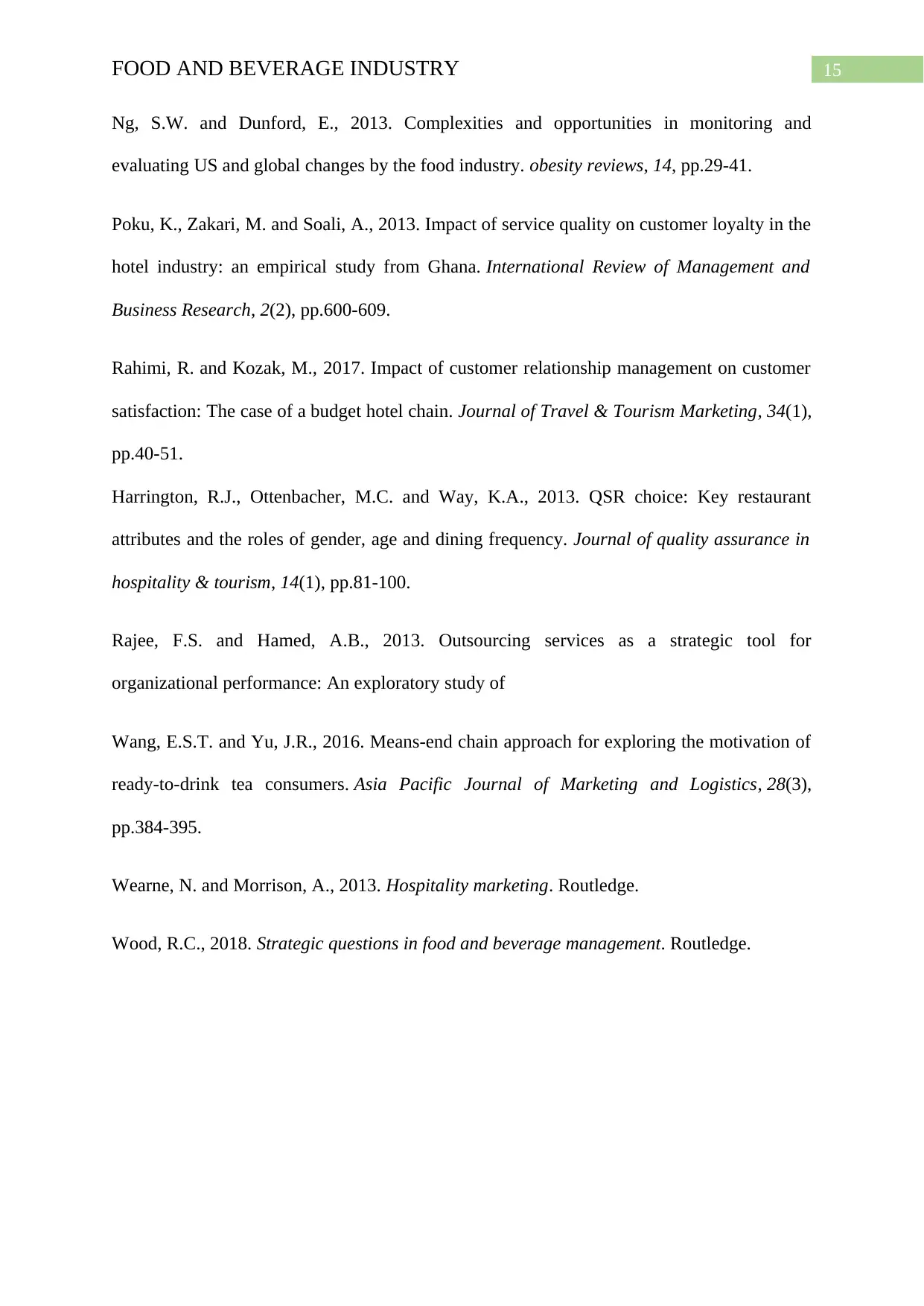
15FOOD AND BEVERAGE INDUSTRY
Ng, S.W. and Dunford, E., 2013. Complexities and opportunities in monitoring and
evaluating US and global changes by the food industry. obesity reviews, 14, pp.29-41.
Poku, K., Zakari, M. and Soali, A., 2013. Impact of service quality on customer loyalty in the
hotel industry: an empirical study from Ghana. International Review of Management and
Business Research, 2(2), pp.600-609.
Rahimi, R. and Kozak, M., 2017. Impact of customer relationship management on customer
satisfaction: The case of a budget hotel chain. Journal of Travel & Tourism Marketing, 34(1),
pp.40-51.
Harrington, R.J., Ottenbacher, M.C. and Way, K.A., 2013. QSR choice: Key restaurant
attributes and the roles of gender, age and dining frequency. Journal of quality assurance in
hospitality & tourism, 14(1), pp.81-100.
Rajee, F.S. and Hamed, A.B., 2013. Outsourcing services as a strategic tool for
organizational performance: An exploratory study of
Wang, E.S.T. and Yu, J.R., 2016. Means-end chain approach for exploring the motivation of
ready-to-drink tea consumers. Asia Pacific Journal of Marketing and Logistics, 28(3),
pp.384-395.
Wearne, N. and Morrison, A., 2013. Hospitality marketing. Routledge.
Wood, R.C., 2018. Strategic questions in food and beverage management. Routledge.
Ng, S.W. and Dunford, E., 2013. Complexities and opportunities in monitoring and
evaluating US and global changes by the food industry. obesity reviews, 14, pp.29-41.
Poku, K., Zakari, M. and Soali, A., 2013. Impact of service quality on customer loyalty in the
hotel industry: an empirical study from Ghana. International Review of Management and
Business Research, 2(2), pp.600-609.
Rahimi, R. and Kozak, M., 2017. Impact of customer relationship management on customer
satisfaction: The case of a budget hotel chain. Journal of Travel & Tourism Marketing, 34(1),
pp.40-51.
Harrington, R.J., Ottenbacher, M.C. and Way, K.A., 2013. QSR choice: Key restaurant
attributes and the roles of gender, age and dining frequency. Journal of quality assurance in
hospitality & tourism, 14(1), pp.81-100.
Rajee, F.S. and Hamed, A.B., 2013. Outsourcing services as a strategic tool for
organizational performance: An exploratory study of
Wang, E.S.T. and Yu, J.R., 2016. Means-end chain approach for exploring the motivation of
ready-to-drink tea consumers. Asia Pacific Journal of Marketing and Logistics, 28(3),
pp.384-395.
Wearne, N. and Morrison, A., 2013. Hospitality marketing. Routledge.
Wood, R.C., 2018. Strategic questions in food and beverage management. Routledge.
1 out of 16
Related Documents
Your All-in-One AI-Powered Toolkit for Academic Success.
+13062052269
info@desklib.com
Available 24*7 on WhatsApp / Email
![[object Object]](/_next/static/media/star-bottom.7253800d.svg)
Unlock your academic potential
© 2024 | Zucol Services PVT LTD | All rights reserved.





